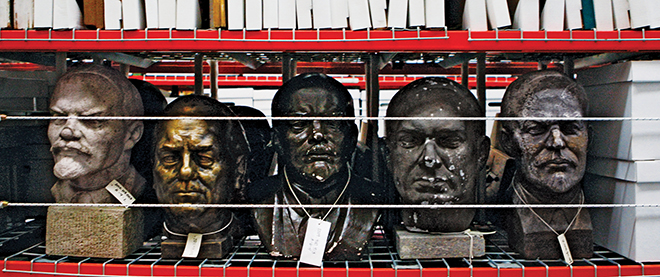A Cold War story told through 70,000 artifacts
Rescuing Germany’s history, one toothbrush at a time
Coleman-Rayner/The Wende Museum
Share

Justinian Jampol created a museum because he had a storage problem.
A decade ago, the young Californian was a graduate student at the University of Oxford, researching visual culture from the Cold War Communist bloc. He worked his way through archives in Berlin and Moscow, but found that the material in them was limited.
“You realize two things,” says Jampol, speaking of the archival material. “They’re the voice of authority, and they’re paper.”
Museums had other flaws. “They’re there to tell you a particular story. There’s a beginning, a middle, an end, and a gift shop. You can’t really engage with it.”
Jampol was more interested in “what was going on between the cracks,” in unofficial, often ignored stories, and the artifacts that reveal and explain them. This led him into a subculture of collectors and scavengers in Eastern Europe who seek out and preserve material from the Soviet era. Many have deep personal ties to the conflicts. They are former secret police agents and political prisoners. Some have kept their own artifacts—everything from forged passports to restaurant menus, party newspapers and secret-police surveillance equipment. Others dig through the networks of now-abandoned bunkers, military bases and closed-off army towns that the Russians left behind when they quit a reunited Germany in 1994.
It was while exploring one such base near Potsdam that was about to be bulldozed where Jampol discovered an entire room full of old film reels. Some were instructional movies for Soviet soldiers on topics such as brushing teeth and wearing socks. It was the sort of “between the cracks” material culture that fascinates Jampol—hidden treasure that was saved before it was lost forever. Yet when he alerted the local government’s cultural attaché, they didn’t want it.
Jampol had his first big cache of artifacts and nowhere to store it. And he kept getting more. Individuals would give him personal belongings from their attics and basements. When he approached a German museum about housing some of the material, the museum instead gave him much of its own Cold War collection.
For a while, Jampol tried to make do with the space he had. He rented cheap apartments in Berlin and filled them with boxes. His dorm room at Oxford piled up with Lenin busts and propaganda posters.
“I was surrounded by this stuff. It got really crazy.”
Eventually, with help from his alma mater, UCLA, and various foundations, Jampol built a home for his collection: the Wende Museum, open in L.A. since 2004. Wende is a German word that means “turning point.” The term encompasses the end of Communism throughout the Soviet bloc.
Today the museum holds some 70,000 artifacts. While the museum is open to the public, and admission is free, it’s as much an archive and educational institution as a traditional museum. Jampol, who is now the museum’s executive director, is expanding its mandate to documenting disappearing history in photographs and films. He has made more than a dozen trips to abandoned Soviet bases in Germany. Departing Russian soldiers took much of what they assumed to be valuable: pipes, toilets, wiring. But they left behind personal photos and painted murals. The wooden backs of chairs in a ruined movie theatre are covered in graffiti. A soldier writes that he misses his girlfriend, Masha, back home in Siberia. “You realize that these are the remnants and fragments of humanity,” says Jampol. “You get this ghost-like feeling.”
Jampol says his most recent trip this past autumn to the abandoned bases near Berlin was likely one of the last. Nature is reclaiming them. It’s a surprisingly fast process. A pipe freezes, the roof collapses and soon grass is growing through the floors.
“Germans don’t go on the weekend and visit these places, and if you do, that’s very suspicious,” says Jampol. He once received a suitcase full of fake visas and passports with a note that said: “I closed this up the day the wall fell and never looked at it again.”